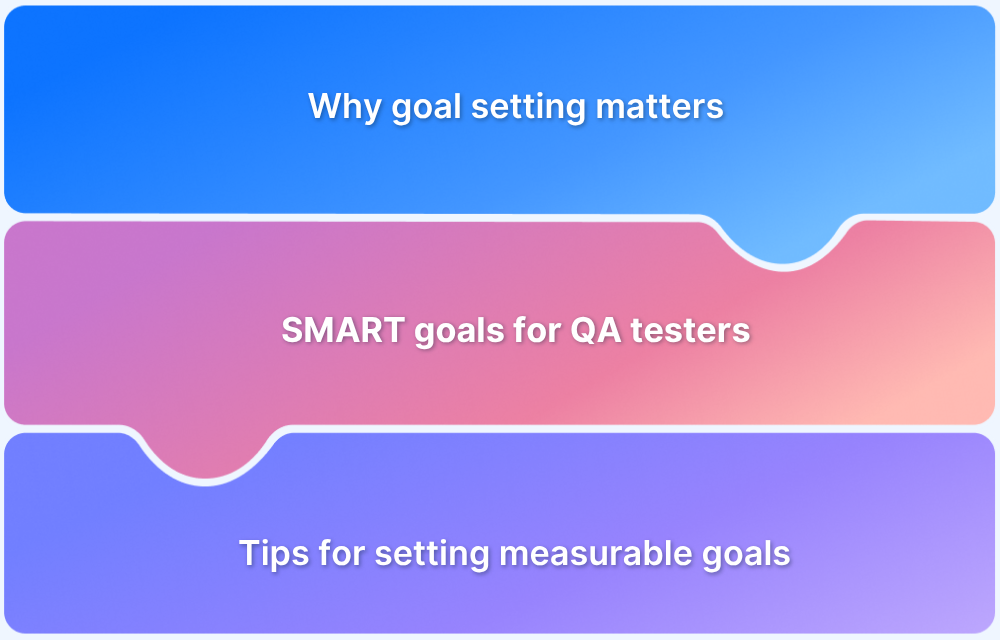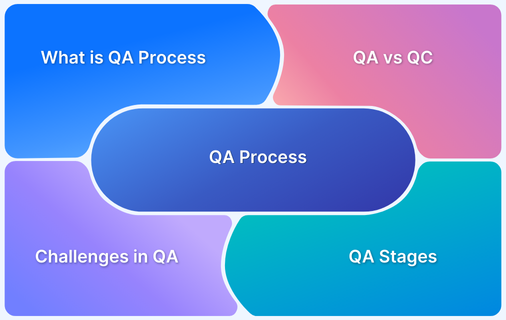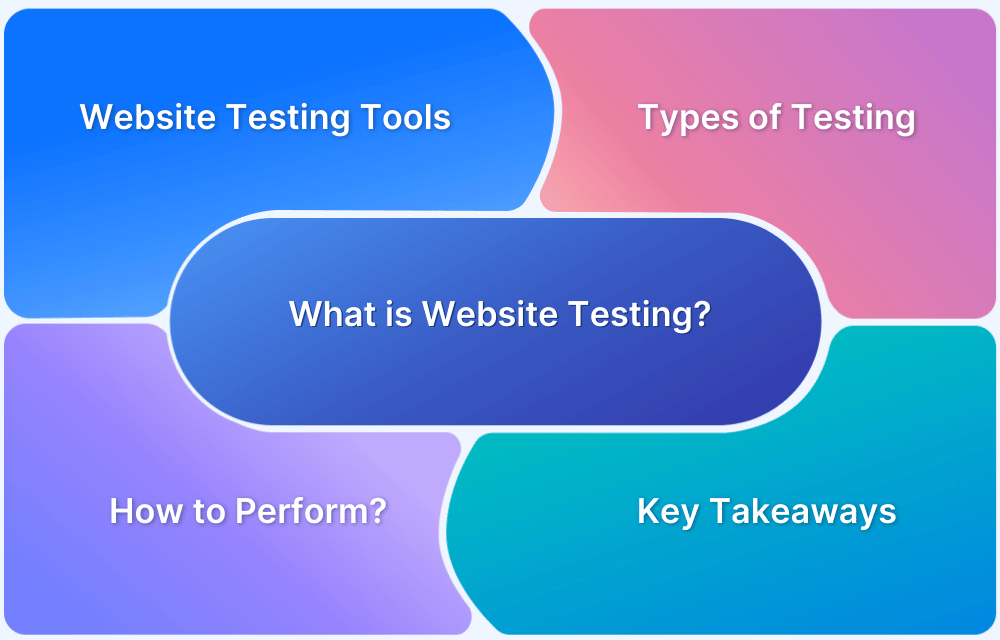Essential metrics give teams the clarity to spot risks early, improve workflows, and deliver higher-quality software with confidence. Focusing on the right data ensures that quality is not left to chance but built into every stage of development.
Overview
20 Essential QA Metrics for Software Quality
Product Quality Metrics:
- Defect Density
- Defect Leakage
- Defect Removal Efficiency (DRE)
- Test Coverage
- Requirements Coverage
- Severity Index
- Priority Index
- Escaped Defects
- Customer-Reported Defects
Process Quality Metrics:
- Test Case Pass Rate
- First-Time Pass Rate
- Automation Coverage
- Bug Reopen Rate
- Mean Time to Detect (MTTD)
- Mean Time to Repair (MTTR)
- Test Design Efficiency
- Build Failure Rate
Project Metrics:
- Test Execution Progress
- Time to Market
- Cost of Quality (CoQ)
This article will discuss about the essential QA metrics that must be set and observed throughout the process to ascertain its performance.
What are Software Quality (QA) Metrics?
Software Quality metrics or QA metrics are quantifiable measures that evaluate the quality, efficiency, and effectiveness of software development and testing.
They provide insights into how well the development process is performing, highlight areas for improvement, and help ensure the final product meets quality standards.
These metrics span across all stages of the software lifecycle, from requirements to deployment and enable data-driven decisions for continuous improvement.
Why are Software Quality Metrics important?
Here are the reasons why Software quality metrics are important:
- Ensure Product Quality: They help verify that the software meets functional and non-functional requirements.
- Drive Continuous Improvement: Metrics highlight inefficiencies and areas requiring attention, enabling ongoing process optimization.
- Enable Data-Driven Decisions: Teams can make informed choices instead of relying on intuition or guesswork.
- Track Progress & Performance: Monitor project health, team productivity, and testing effectiveness over time.
- Detect Issues Early: Early trends in metrics can uncover defects or bottlenecks before they escalate.
- Support Compliance & Standards: They assist in meeting regulatory and industry-specific quality standards.
- Improve Customer Satisfaction: Higher quality software leads to better user experiences and fewer post-release issues.
Classification of Software Quality (QA) Metrics
Once metrics are identified as absolute (quantitative) or derived (qualitative), they are further classified based on what aspect they measure:
- Product Metrics: Measure the quality and characteristics of the software product itself (for example, defect density, customer-reported defects).
- Process Metrics: Measure the effectiveness and efficiency of the QA and development processes (for example, mean time to repair, bug reopen rate).
- Project Metrics: Measure project progress, timelines, resource usage, and costs (for example, time to market, cost of quality).
Top 20 Metrics for Software Quality
Here are the top 20 essential metrics for Software Quality:
Product Quality Metrics
1. Defect Density
Measures how many defects are found in a given size of software. It helps assess overall code quality and maintainability.
How to Calculate: (Total Defects) ÷ (Size of Software, e.g., Lines of Code or Function Points)
2. Defect Leakage
Tracks how many defects escape into production after testing. It helps evaluate the effectiveness of testing efforts.
How to Calculate: (Defects after release ÷ Total defects found during testing) × 100
Read More: Defect Management in Software Testing
3. Defect Removal Efficiency (DRE)
Shows the percentage of defects detected and removed before release. It helps measure how well the QA process catches issues early.
How to Calculate: (Defects found before release ÷ (Defects before + after release)) × 100
4. Test Coverage
Measures how much of the codebase or functionality has been tested. It helps ensure comprehensive validation of features and reduces risk.
How to Calculate: (Number of items tested ÷ Total number of items) × 100
5. Requirements Coverage
Indicates the percentage of requirements that have corresponding test cases. It ensures that all documented requirements are verified.
How to Calculate: (Requirements Tested ÷ Total Requirements) × 100
6. Severity Index
Assesses the overall impact of current defects based on their severity. It helps prioritize defect resolution based on potential harm.
How to Calculate: (Sum of (Severity Level × Number of Defects at that Level)) ÷ (Total Defects)
7. Priority Index
Measures the weighted importance of unresolved defects. It ensures that high-priority issues are addressed before release.
How to Calculate: (Sum of (Priority Level × Number of Defects at that Priority)) ÷ (Total Defects)
8. Escaped Defects
Counts the number of defects discovered by users after launch. It highlights critical gaps in pre-release testing.
How to Calculate: Number of production defects
9. Customer-Reported Defects
Counts the number of defects found and reported by customers. It directly reflects customer satisfaction and product reliability.
How to Calculate: Total number of customer-reported defects
Process Quality Metrics
10. Test Case Pass Rate
Indicates the percentage of test cases that pass successfully. It helps gauge the stability of the application at a given time.
How to Calculate: (Test Cases Passed ÷ Total Test Cases Executed) × 100
11. First-Time Pass Rate
Shows the percentage of test cases that pass in their first execution. It reflects the readiness and quality of the software build.
How to Calculate: (Test Cases Passed First Attempt ÷ Total Test Cases Executed) × 100
12. Automation Coverage
Tracks the proportion of test cases that are automated. It helps measure test efficiency, repeatability, and scalability.
How to Calculate: (Automated Test Cases ÷ Total Test Cases) × 100
13. Bug Reopen Rate
Measures how often bugs thought to be fixed are reopened. It helps assess the quality of fixes and the reliability of defect resolution.
How to Calculate: (Reopened Bugs ÷ Total Fixed Bugs) × 100
Read More: Bug Severity vs Priority in Testing
14. Mean Time to Detect (MTTD)
Shows how quickly defects are detected after introduction. It helps minimize the time defects remain hidden and reduces potential damage.
How to Calculate: (Sum of detection times) ÷ (Total number of defects)
15. Mean Time to Repair (MTTR)
Measures the average time taken to fix a defect after detection. It reflects responsiveness and the efficiency of the development and QA teams.
How to Calculate: (Sum of repair times) ÷ (Total number of defects fixed)
16. Test Design Efficiency
Measures how quickly and effectively test cases are created. It helps improve the productivity of the test design phase.
How to Calculate: (Test Cases Designed ÷ Test Design Hours)
17. Build Failure Rate
Shows the percentage of builds that fail during testing. It helps assess the stability of builds being delivered by development teams.
How to Calculate: (Failed Builds ÷ Total Builds) × 100
Project Metrics
18. Test Execution Progress
Tracks how much of the planned testing has been completed. It helps monitor project testing status and detect schedule risks early.
How to Calculate: (Test Cases Executed ÷ Test Cases Planned) × 100
19. Time to Market
Measures the total time taken from project start to product launch. It is critical for maintaining competitiveness and responding to market needs.
How to Calculate: (Release Date) – (Project Start Date)
20. Cost of Quality (CoQ)
Represents the total investment needed to achieve and maintain product quality. It helps balance cost management with quality outcomes.
How to Calculate: (Cost of Prevention + Cost of Detection + Cost of Internal Failures + Cost of External Failures).
Best Practices for measuring Software Quality
Here are some of the best practices for measuring software quality metrics:
- Define Clear Objectives: Know what you want to measure, like defect density, test coverage, or code maintainability and why.
- Align Metrics with Business Goals: Ensure metrics reflect what matters most to stakeholders, such as reliability, performance, or user satisfaction.
- Use a Balanced Set of Metrics: Combine process, product, and people metrics for a holistic view.
- Avoid Vanity Metrics: Don’t rely on numbers that look good but offer little insight (for example, total test cases written without measuring pass/fail or coverage).
- Automate Data Collection: Leverage tools for CI/CD, test automation, and code analysis to gather consistent, real-time data.
- Set Benchmarks & Thresholds: Define acceptable quality levels to assess performance against expectations.
- Encourage Transparency & Collaboration: Share metrics across teams to align efforts and foster collective ownership of quality.
- Continuously Review & Adapt: Periodically assess the relevance and impact of metrics, and refine them as project needs evolve.
Why use BrowserStack to track QA Metrics?
Managing software quality metrics across a fragmented QA ecosystem is one of the biggest challenges modern engineering organizations face.
With multiple teams, disconnected tools, and growing release velocity, gaining unified visibility into test effectiveness, coverage, and defect trends becomes overwhelming.
BrowserStack’s Quality Engineering Insights (QEI) is purpose-built to solve this challenge.
QEI is a centralized analytics dashboard that aggregates critical quality metrics from your test suites, CI/CD pipelines, and issue trackers. It helps gain visibility into software quality throughout the development lifecycle.
While teams may track absolute and derived QA metrics such as test effectiveness, defect leakage, or test automation percentage, this data often lives in silos across Jira, Jenkins, TestRail, GitHub Actions, and more.
QEI brings it all together to answer key questions like:
- How effective is our testing across teams?
- Where are quality bottlenecks forming?
- Are we improving over time?
- Is QA becoming a release blocker?
Key Benefits of QEI
- Unified Quality Dashboard: Consolidate data from Jira, Jenkins, TestRail, GitHub Actions, Zephyr, Azure Pipelines, BrowserStack Test Management, BrowserStack test Observability, and more.
- Actionable Analytics: Track KPIs like test coverage, defect trends, and QA team productivity.
- Customizable Reporting: Tailor views for different stakeholders like Quality enablement teams, QA managers, and leadership.
- Smart Alerts: Get notified when a key metric drops below the expected threshold.
- Benchmark QA Performance: Compare across teams, sprints, or releases to justify QA efficiency initiatives.
Conclusion
BrowserStack Quality Engineering Insights (QEI) simplifies tracking and managing QA metrics from a centralized dashboard. It integrates with CI/CD pipelines and popular tools like Jira, Jenkins etc., enabling real-time visibility into software quality.
By consolidating data across tools, it helps teams make data-driven decisions, improve release quality, and ensure accountability at every stage of the development cycle.







